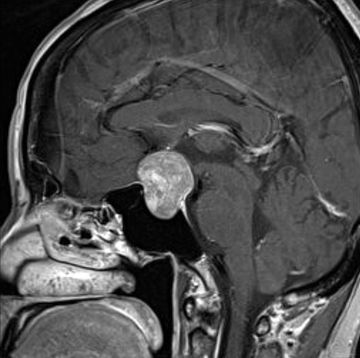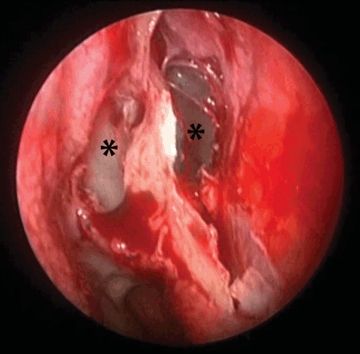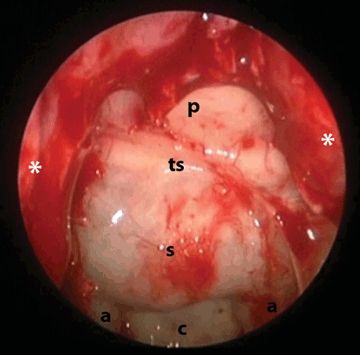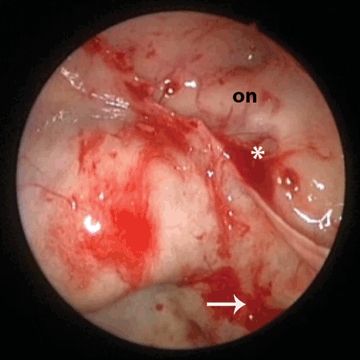FIGURE 2.1 T1-weighted gadolinium-enhanced MRI sequence in coronal view of patient 1 revealed a large pituitary macroadenoma.

FIGURE 2.2 T1-weighted gadolinium-enhanced MRI sequence in sagittal view of patient 1 revealed a large pituitary macroadenoma.
1.The nasal cavity is decongested by placing two Neuro Patties soaked in 4% cocaine on each side about 20 minutes prior to induction of anesthesia. The patient is placed under general anesthesia in the supine position. Antibiotics, glucocorticoids, and antihistamines are administered. We routinely use cefazolin (2 g, intravenous), dexamethasone (10 mg, intravenous) and diphenylhydramine (50 mg, intravenous). Oral endotracheal intubation is used, and a pack is placed in the pharynx. The endotracheal tube is anchored on the left angle of the mouth to keep the chest free as manipulation of the endoscope over the chest may occasionally dislodge the endotracheal tube. A Foley catheter is routinely inserted into the bladder to monitor urinary output intra- and postoperatively. The patient’s head is supine and turned slightly to the right. The head is elevated by about 30 degrees above the heart to facilitate venous drainage. Antiseptic solution (such as a 5% povidine–iodine solution) is applied to the nose and mouth, and the area is draped with sterile towels and Steri-Drape. The lower abdomen is prepared and draped to obtain adipose tissue for grafting if necessary.
2.The Neuro Patties that had been placed in the nasal cavity earlier are removed and discarded. The nasal cavity is once again decongested with topical application of cocaine. Sterile Neuro Patties soaked in 4% cocaine are placed endoscopically in the sphenoethmoid recess bilaterally. Allowing about 10 minutes for decongestion, the Neuro Patties are removed and the sphenoethmoid recess is infiltrated bilaterally with 1% lidocaine with 1:80,000 epinephrine. A gauge 21 spinal needle is used for infiltration of the anterior wall of the sphenoid, sphenopalatine foramen, and the posterior aspect of the nasal septum.
3.After the nose has been adequately decongested, an endoscopic examination is performed using a 0-degree or 30-degree endoscope. The ostia of the sphenoid sinus are identified bilaterally.
4.Surgery is started on the side where the sphenoid ostium is better visualized. In most cases, we start on the right side. The microdebrider with a 4-mm bit and a serrated outer shaft is used to debride the mucosa in the sphenoethmoid recess around the ostium of the sphenoid sinus taking care not to traumatize the mucosa on the superior turbinates. The serrated blade of the microdebrider is directed medially and the outer sheath laterally protecting the mucosa of the superior turbinate. The sphenoid ostium is widened inferiorly and medially down to the floor of the sphenoid sinus. Care is taken to avoid the septal branch of the sphenopalatine artery (SPA) by not going too far inferolaterally. A 2-mm up or down biting Kerrison rongeur is used to extend the sphenoidotomy. Mucosa is debrided from the posterior aspect of the vomer and the sphenoid rostrum. The sphenoidotomy is extended to the contralateral side by dislocating the attachment of the vomer from the sphenoid rostrum. The ostium of the sphenoid sinus on the contralateral side is identified, and the sphenoidotomy is extended as far as the contralateral superior turbinate (Fig. 2.3). The sphenoid rostrum is removed with strong septal forceps. A wide sphenoidotomy that extends superiorly to the roof of the sphenoid, inferiorly to the floor of the sphenoid sinus, and laterally to the superior turbinate on either side is fashioned.
5.About 1 cm of the posterior aspect of the vomer is removed with a reverse cutting forceps to facilitate the introduction of instruments from both nostrils. A panoramic view of the sphenoid sinus is obtained. The removal of part of the posterior nasal septum provides the ability to use both hands by two surgeons enabling introduction of up to four separate instruments, two through each nostril. The access to the sphenoid sinus is complete (Fig. 2.4). From this point onwards, the neurosurgeon and otolaryngologist work as a team. The otolaryngologist manually manipulates the endoscope and assists the neurosurgeon in removal of the tumor.
6.The sphenoid sinus is next examined with 0-degree, 30-degree, and 70-degree, 4-mm endoscopes, and important anatomical landmarks within are noted. Of particular importance are the structures on the lateral wall. The carotid prominence, optic prominence, and opticocarotid recess can be well identified when the sphenoid sinus is well pneumatized (Fig. 2.5). On the lateral recess of a well-pneumatized sphenoid sinus, the second branch of the trigeminal nerve (V2) and the vidian canal may be identified superolaterally and inferomedially, respectively.
On the posterior wall, the tuberculum sella, the anterior wall of the sella, and the clival recess are identified. The location of the intersinus septa, if any, is noted. Caution is exercised in not stripping the sphenoid mucosa as this may result in considerable bleeding. Once a panoramic view of the entire sphenoid sinus and the surgical landmarks is obtained, the access to the sella turcica is complete. The major landmarks for proper identification of the sellar floor are the planum sphenoidale above, clivus below, and carotid prominences bilaterally. Neuronavigation, if available, is used to confirm the landmarks (Fig. 2.6).
7.Once the sellar floor has been identified, the mucosa over the floor of the sella is cauterized with bipolar diathermy to expose underlying bone. The thickness of the floor of the sella is assessed by gentle palpation with an instrument such as a ball probe. By direct visualization and tactile feedback, the thinnest part of the sellar floor is identified and gently fractured at the point of least resistance. A plane is developed between the dura and floor of the sella with a right-angle hook. A 1-mm Kerrison punch or a curette is used to delicately remove the floor of the sella exposing dura. Boundaries of removal of the sellar floor are the planum sphenoidale superiorly, clivus inferiorly, and the carotid prominence laterally (Fig. 2.7).
8.Bipolar diathermy is used for hemostasis over the dura before incising it. The incision is made using a sickle knife or a scalpel with a retractable blade or a pair of 45-degree-angle alligator scissors.
9.A biopsy of the tumor tissue is taken. Once we have sufficient tumor tissue for a histologic examination, the tumor is removed using a combination of blunt ring curettes and pituitary forceps. The otolaryngologist and neurosurgeon work in tandem at this point. While one surgeon removes the tumor, the other provides continuous suction enabling rapid removal. A systematic approach in removing the tumor is useful. We start to remove tumor from the floor, work on the lateral extent next, and finally remove the suprasellar component if any. Often the tumor decompresses rapidly in areas where it is cystic or gelatinous. The diaphragma may descend rapidly in this region, giving the impression that the tumor has been completely removed, whereas pockets of tumor where the tumor was more semisolid or adherent to the diaphragma may be left behind. Therefore, it is useful to attempt to control the descent of the diaphragma by systematic removal of the tumor. When the diaphragma descends unequally, there may be a pocket of tumor left behind. A careful inspection of such pockets is done by gentle retraction of the arachnoid by one surgeon to enable visualization while the other removes any residual tumor.
10.Once the tumor has been removed, a 4-mm-angled endoscope (30-degree, 45-degree, or 70-degree) is used to view the cavity of the sella and suprasellar cistern to ensure absence of residual tumor (Fig. 2.8). Lateral visualization with angled endoscopes enables exploration of the medial wall of the cavernous sinus.
11.Once the tumor has been completely removed, minor oozing from the sella is controlled by packing it with Neuro Patties providing a tamponade for about 5 minutes. Upon removal of the Neuro Patties, the sella is once again examined endoscopically and any localized oozing is controlled with placement of Surgicel (Johnson & Johnson, New Brunswick, NJ) over the area. In the situation where oozing from the sella persists despite the above measures, it may controlled by application of thrombin-infused gelatin matrix (FloSeal; Baxter International Inc., Deerfield, IL).
12.Once the surgery is concluded, nasal hemostasis is ensured. Any minor mucosal oozing or bleeding from the septal branch of the sphenopalatine artery is controlled with bipolar diathermy.
13.The cavity of the sella is lined by a thin film of Surgicel. Repair of the defect in the sella is not routine. A thin film of Surgicel is placed over the defect.
14.To facilitate postoperative healing of the mucosa, we ensure that the bone of the sphenoid rostrum is not exposed and is adequately covered with mucosa. Eight-centimeter nasal Merocels (Medtronic Xomed Surgical Products, Jacksonville, FL) are placed in the nasal cavity on either side and hydrated with saline to expand. These are removed after 24 hours.

FIGURE 2.3 Bilateral sphenoidotomy (black asterisk).

FIGURE 2.4 Wide midline sphenoidotomy limited laterally by the superior turbinates (white asterisk) providing access to the sella (s). Other structures visible are the planum sphenoidale (p), tuberculum sella (ts), clivus (c), and the paraclival carotid arteries (a).




